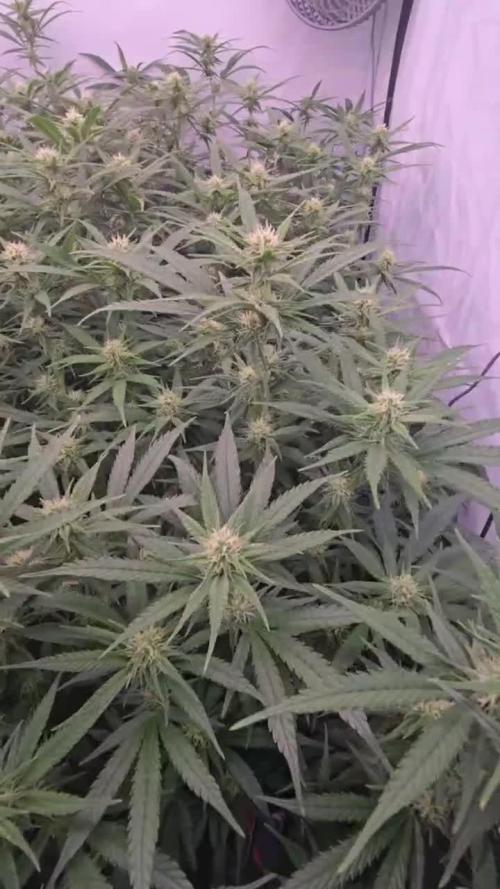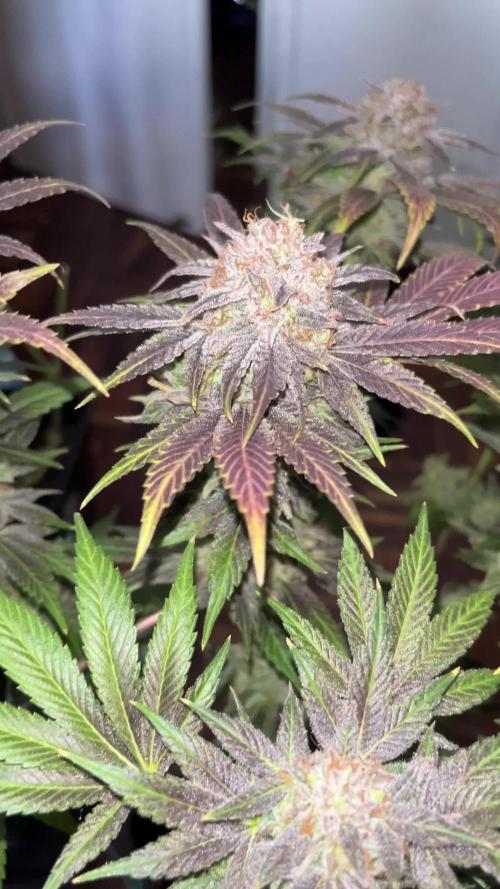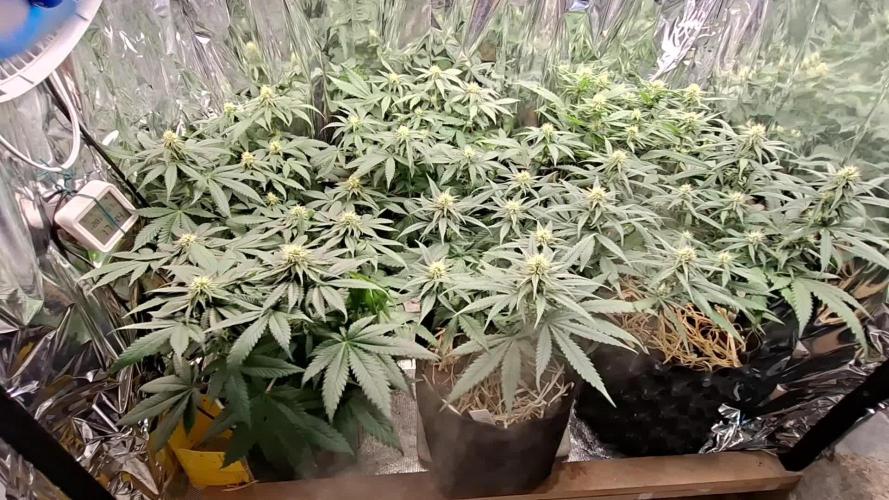The Grow Awards 2026 🏆 





























Likes
17
Share


@GardenOfHerbs
Follow
* harvest: 8 weeks veg. 60 days flowering
* pot size: 10liter air-pot
* dry bud yield: 59gram
* Appearance: the most frosty buds i have ever seen in my life. Its shining like a diamond. I could look at them all day
* Bud density: 10/10
* Aroma : smelling like gas with a mix of ripe peaches
* Taste : damn the peach terps are insane on the inhale, a strong gas taste on the exhale
* Potency : 10/10
* Kind of high: next level strong, like you are smoking extracts
* Colour of thrichs at time of harvest: 20% amber 80% milky
* Drying time: 10 days in the dry tent, curing 10 days
* Good comments: This has to be the frostiest plant i have ever grown, the trichome/resin production on this plant is insane and never seen before. Also one of the prettiest plants i have grown, the leaves turned out completely dark purple/black at the end of flower. The terpenes on this plant are incredible. Im super impressed by this seedbank and i will definitly grow more from them.
* bad comments: this pheno wasnt a heavy yielder but thats ok, quality over quantity
Likes
28
Share


@MadeInGermany
Follow
Hey guys :-)
A lot has happened this week :-).
She has developed very well.
Today it was topped on the main shoot for the first time.
How often I will use topping on her, I make it dependent on how everyone else develops.
I want to bloom soon so it won't happen very often :-).
It was poured twice this week with 1 l each time (for nutrients, see table above).
Fast plant spray from GBL was applied 2 times this week.
New was added this week Fast Bud from GBL is preparing her for the coming flowering.
Bio Grow Stay away for a while because the substrate is 30-50 % consists of fresh earth and the ladies are nice and dark green :-).
Today there was another spray with neem oil against the remaining tripse which I will repeat one last time next week.
As always, everything was cleaned and checked.
Have fun with the update and stay healthy 🙏🏻
👇🏼👇🏼👇🏼👇🏼👇🏼👇🏼👇🏼👇🏼👇🏼👇🏼👇🏼👇🏼
You can buy this Nutrients at :
https://greenbuzzliquids.com/en/shop/
With the discount code: Made_in_Germany you get a discount of 15% on all products from an order value of 100 euros.
👇🏼👇🏼👇🏼👇🏼👇🏼👇🏼👇🏼👇🏼👇🏼👇🏼👇🏼👇🏼
Water 💧 💧💧
Osmosis water mixed with normal water (24 hours stale that the chlorine evaporates) to 0.2 EC. Add Cal / Mag to 0.4 Ec Ph with Organic Ph - to 5.8 - 6.4
MadeInGermany
Likes
15
Share


@HydroLab-Germany
Follow
*english version below*
Blütewoche 3 – Das kontrollierte Chaos im Citrus-Labor
Diese Woche hatte im Zelt etwas von einem wissenschaftlichen Versuch, der langsam beginnt, außer Kontrolle zu geraten – aber genau so, wie wir es wollen.
Wachstum & Struktur
Der Stretch hat sich nun offiziell beruhigt. Die Pflanzen tun jetzt so, als wären sie die ganze Zeit vollkommen zivilisiert gewesen. Statt Höhenrausch gibt’s nun fokussiertes Kraftbündeln in die Blüten.
Das Dach ist mittlerweile eine homogene, grüne Welle, sauber ausgerichtet wie ein geordnetes Blatt-Array.
Oben wurde schon etwas entlaubt – so viel, dass man es inzwischen kaum noch sieht, weil die Damen schneller nachlegen als man schneiden kann. Der große Eingriff steht aber noch aus:
Lollipopping Phase II – die chirurgische Endrunde.
Wenn der untere Bereich fertig freigestellt ist, bleibt nur noch pure Effizienzmaschine übrig: Stamm, Weg, Bud.
Blütenentwicklung
Die Blütenstände haben diese Woche einen riesigen Sprung gemacht.
Von „Wir probieren mal was aus“ zu
„Okay, jetzt legen wir richtig los“.
Die Cluster sind gut verteilt, dicht, voller frischer, weißer Pistillen und alles schreit danach, dass die nächsten Wochen interessant werden.
Und das Beste:
Reib mal an einem Zuckerblatt – da kommt dir schon jetzt dieses knackige Zitronenterpen-Profil entgegen. So klar und frisch, dass es fast im Auge brennt… im positiven Sinne.
Systemstatus – läuft wie ein Uhrwerk
EC: stabil bei 1.5
Wassertemperatur: 19°C – Chiller arbeitet wie ein Kühlschrank auf Red Bull
Raumtemperatur: 25°C
RLF: 58–60% → perfekte VPD für frühe Blüte
pH: brav stabil, keine wilden Ausreißer
Technik-Showcase
Die Under-Canopy-Beleuchtung sorgt jetzt für diesen „UFO-Unterboden-Glow“, der aussieht, als würden die Pflanzen gleich abheben.
Das RDWC läuft absolut glasklar, O₂-Sättigung im Premiumbereich und die Mars Hydro oben drüber macht fleißig Druck.
Und dann noch das neue Gadget:
Dein Mikroskop.
Ein Spielzeug, das vermutlich gefährlicher ist als jedes Add-On im Zelt, denn man will plötzlich ALLES analysieren: Harzköpfchen, Blattzellen, PPSI-Strukturen… und wahrscheinlich irgendwann auch, ob die Pflanzen heimlich zurückwinken.
Fazit der Woche
Blütewoche 3 bringt Stabilität, Aroma, Spannung und Vorfreude.
Der Stretch ist vorbei, die Bühne gehört jetzt den Blüten – und die liefern.
Mit der kommenden Lollipop-Operation und weiterem Lichtdruck dürfte die Anlage jetzt in die Phase kommen, in der man sich fragt:
„Wie voll kann ein 120er Zelt eigentlich werden, bevor es rechtlich als Landwirtschaft gilt?“
--------------------------------------------------
Flowering Week 3 – Controlled Chaos in the Citrus Laboratory
This week inside the tent felt like watching a scientific experiment slowly slip out of control —
but exactly in the way we hoped for.
Growth & Structure
The stretch has officially calmed down. The plants are now pretending they were perfectly civilized all along.
Instead of reaching for the sky, they’re now channeling all energy into bud production.
The canopy has turned into a uniform green wave, aligned like a carefully arranged leaf array.
Some defoliation was done earlier, though the girls have grown so fast that it’s barely noticeable anymore.
But the big procedure is still ahead:
Lollipopping Phase II – the surgical finale.
Once the lower section is fully cleaned, only pure efficiency remains: stem, pathway, bud.
Bud Development
The flowers made a huge jump this week.
They went from “We’re experimenting…” to
“Alright, now we’re getting serious.”
The clusters are evenly distributed, dense, and bursting with fresh white pistils — everything is signaling that the next weeks are going to be fun.
And the highlight:
Rub one of the sugar leaves… that crisp lemon terpene profile already hits you. Sharp, fresh, and almost stinging the eyes — in the best possible way.
System Status – Running Like a Machine
EC: steady at 1.5
Water Temp: 19°C – chiller performing like a fridge on energy drinks
Room Temp: 25°C
RH: 58–60% → ideal VPD for early bloom
pH: stable and obedient
Tech Showcase
The under-canopy lighting now creates this “UFO glow” underneath the plants — looking like the whole root zone is preparing for lift-off.
RDWC is crystal clear, O₂ levels are premium, and the Mars Hydro above is pushing photons like it means it.
And then… the new gadget:
Your microscope.
A toy more dangerous than any nutrient bottle — because suddenly you want to analyze EVERYTHING: trichomes, leaf cells, stomata, probably even if the plants secretly wave back.
Weekly Verdict
Flower Week 3 brings stability, aroma, excitement, and anticipation.
The stretch is done, the stage belongs to the buds — and they’re delivering.
With the upcoming lollipopping operation and increasing light intensity, the setup is entering that phase where you start to wonder:
“How full can a 120×120 tent get before it legally counts as agriculture?”
Likes
153
Share


@PigBearMan
Follow
High,
the Canna Professional Plus soil had mourning mosquitoes in it (second time I have the same problem with Canna soil).
I "fight" them with Culinex pills (B.t.i.) and neem oil - works pretty good. They are almost gone.👍
I peg the leaves down, so that more light can penetrate the sprouts.
EC is 1,2 with Canna Terra Vega (first and last time in veg phase).
They will get another shower with neem oil the day I send them into flowering.
Stay green. 💪
Likes
13
Share


@Alpha_Green
Follow
Some of you may have wondered:
Why do I use CO2 at average 950 ppfd μmol/m2/s (moral flow)?
The answer is quite simple. Because of lack of space in some regions of my cultivation area, I simply cannot keep the ideal distance to my Sanlight high-performance lamp, due to some height growth of various strains. And so some of the main colas have ppfd values of 1250 μmol/m2/s and even more...
So this is how I manage to achieve and compensate for such high radiation levels even with a CO 2 balance. And I have to say, my strategy to avoid various light stress symptoms works just fabulously. In combination with CO 2 implementation, my babies are simply unbeatably insensitive to light. Thats it!
Beginning of 3rd week flowering:
Again feeding my babies by 36 hours fermented potions of Bio Tabs Kompost Tea PK-Booster (15 g pro Liter) and added:
5ml Orgatrex/Liter
1 Spoon of Bactrex
1 Spoon of Mycotrex
1 Spoon of Mycco-Vital
1 Spoon of Dynomyco
A little tip for those who are interested in small modifications that have a big difference or influence - on the result - effect - beauty - health - taste! Before adding microorganisms or beneficial bacteria or Mycorrizae and Trichodermas, please use oxygen-saturated water. On the one hand, unwanted chlorine gases evaporate and the small world of the microbiome becomes even faster and more rewarding in compost tea to sprout.
Last but not least for this week, I would like to introduce my reasons, why I prefer growing biologically and sustainably.
First of all, it’s something which suits very well in these times/days we are living now. Sustainability is a big need and task for our planet. 🌎 Nature means life. Our home, the air we breathe and everything that surrounds us. Not just today. Hopefully tomorrow as well.
Maybe I'm starting to protect our environment on a small scale, but maybe I can also make a big difference at all.
If you change the way you look at things, the things you look at change...
I thought about what’s the difference, between Mineral Feeding and Super Soil Feeding.
It’s very easy. Biologically Growing is a similar process than the natural soil activities out there in the lap of nature’s. So plants has to work and interact with the microorganisms and microbiomic communities in the soil. So the plants will never get lazy like the lazy ones of mineral feeding growers.
If you grow biologically, you will feed the soil first and the microorganisms will support every parameter next to your plant conditions. And that will generate an unbelievable spectrum of Terpenes and Trichomes you will never forget.
It’s the same comparison, when you daily visit McDonalds and you eat only fast food. How does your body and mind react on this shit for money?!?!
May I invite you to think about it…
See you next week dear Growmies! Have a nice Weekend and take care…
Peace out!
Addendum for Day 53:
At the moment we unfortunately have another winter onset here in Germany. This means that I am forced to take additional heating measures due to structural facts in order to be able to keep the temperatures constant. After all, just tonight the thermometer climbs again to -1 degree Celsius.
In addition, my exhaust air system runs out of my bedroom terrace and I therefore grow winter and summer with the patio door open. Well, sometimes I experience real weather-related challenges. But all in all, no problem...
"Where there's a will, there's a way."
Addendum to pouring out the fermented PK tea: I always administer half a liter of lukewarm aerated water with 3.5 ml of cannazyme per liter to each plant. This means that the "root machine" is not supplied with supplies unprepared and the nutrient solution can thus also be better distributed in the soil. Since I also work with cloth shoes, I spray them evenly moistened everywhere with water that is also warm before pouring them out from the outside. This has the advantage that the moisture stays where it should: in the pot!
... I did the math today ;-) We are still in week 7 until this Friday. And week 8 starts on Friday! OMG... still so much time yeahh!
Today my Fast Buds Sour Jealousy and Sweet Seeds Big Devil and Dark Devil Automatics arrived. I'm looking forward to it.
This time Fast Buds next Time Sweet Seeds. Love them too. Very beautiful genetics.
Today a review video of the beginning of week 3.
At the time of the pictures, I had minor signs of nitrogen excess. (Light peaks first at the crown of the roof and then slightly continuing to the middle section.) I then painstakingly racked my brains as to why this could be. I found that very slight dry spots had formed and therefore the root found small accumulations of nitrogen that caused its problems. But then, when I carefully homogeneously checked the moisture content in the substrate, the problem evaporated again. However, they had not shown any loss of growth rate during this time. Nevertheless, they developed as expected.
They Strawnanas had no problem with that.
In the end, I always have a hard time killing them. But I guess that's the way things go.
We live and die.
We come and go.
But it's not there yet. ;-)
Tomorrow is day 56.
Tomorrow’s updating day!
Can't wait to see their progress.
Have a good time and see you tomorrow… 🏽🕊️
🏽 ☮️🕊️
Likes
4
Share


@The_Projexx
Follow
Welcome to week 6 of flower for this lovely project! Last week was exciting this week should be even more exciting! With the ladies beginning to put on serious weight it's only a matter of time before I'll have to install a second net to help support the branches. With this being about the halfway point I'm excited to see them at the finish line!
Huge shout outs to @MarsHydroLED for making epic lights and tents for people to grow in!
Huge shout outs to all my followers and people who stop into the diary alike! Keep inspiring to grow!
-The Projexx
Day#36F Creamy Cereal is PUMPING frost now with its undeniable smell of fruit loops and milk.
Day#37F Ladies are putting on mass and quickly!
Day#38F Macmelonz continues to stretch and stack but looks like its nearing the end for her stretch phase. Hopefully she pumps HUGE kickass flowers for me.
Day#39F Flowers are almost the size of a soda can now. The trichomes on these plants are wild like trichomes over trichomes. The flowers have really picked up on the aroma department as well very please with the plants.
Day#40F Raised the light abit, Flowers are starting to display colour in them now can't wait to see them in a few weeks!
Day#41F Pictures N/A. Ladies are still beefing up flowers some of the pistols are starting to turn.
Day#42F Ladies are still putting on mass daily. Lots of lovely unique smells coming from the plants.
Recap: Things went well this week , the ladies really put on some mass and all the flowers are hard as rocks! I will be taking away leaves over the course of the coming weeks to ensure the airflow to the flowers. Excited to see what the coming weeks bring!
Likes
6
Share


@High_And_Hydro
Follow
Sie sieht soweit gut aus, aber spargelt ein wenig. Vielleicht liegts daran, dass sie erst gegen 11 Uhr direkte Sonne bekommt.
Processing
Likes
2
Share


@midEastern
Follow
I think flowering is initiated..worst case I will have 9th week of flowering
Likes
50
Share


@DogDoctorOfficial
Follow
🌱 Eternity Grow Cup: Week 1 Report – The Journey Begins 🌟
First and foremost, a huge thank you to Grow Diaries, the incredible community, and all the amazing sponsors that make this journey possible. Big shoutouts to my core supporters: Aptus Holland, Pro-Mix Soil, TrolMaster, ThinkGrow LED, Future of Grow LED, and CannaKan. And for this special Eternity Grow Cup run, I’m deeply grateful to have Zamnesia and Plagron on board, providing seeds and the game-changing Green Sensation. Your support inspires me to put my all into this grow! 💚
🌿 Week 1 Highlights: Slow but Steady Progress
This week has been all about resilience and careful nurturing. Despite colder-than-ideal temperatures, the Zamnesia Runtz seedlings are showing their strength and determination. Here’s how things are looking:
Environment Stats
• Daytime Temps: ~18°C
• Nighttime Temps: ~14°C
• Humidity (RH): ~60%
• Root Support: Heating mat keeping the root zone warmer, ensuring the seedlings stay cozy even when ambient temps drop.
Growth Update
• All five phenos (labeled Runtz #1–5) have sprouted and are now showing their first leaves.
• Growth is slow due to the low temperatures, but the Pro-Mix HP with Biofungicide and Mycorrhizae is proving to be an amazing medium—supporting healthy roots and steady development.
• No nutrients yet, just plain water, allowing the seedlings to establish themselves naturally in this excellent soil.
Faith in the Pheno Hunt
I’m holding onto the dream of finding that special passion-fruit pheno I adored in the past. It’s still early days, but I believe in the magic of this strain and the promise each seed holds.
Educational Focus: Germination to Week 1 Care
The Importance of Root Warmth in Cold Conditions
Maintaining a consistent root-zone temperature is crucial when growing in a cold environment. Here’s how I’ve adapted:
• Using a heating mat under the pots to keep the roots warm while the surrounding air remains cooler.
• Ensuring the soil stays evenly moist, as dry conditions can amplify the impact of cold.
Minimal Feeding Philosophy
For the first week, I stick to plain water—letting the soil and its microbial life do the heavy lifting. This allows the seedlings to establish strong roots without risk of overfeeding or salt buildup.
Patience is Key
Early growth may seem slow, especially in cooler climates, but this is the foundation stage. Each small leaf and root is setting the stage for explosive growth in the weeks to come.
Visual Storytelling: A Peek Behind the Scenes
This week, I’ve documented every detail through photos and videos to share the full story:
• Photos: Close-ups of all five phenos, capturing their early beauty.
• Videos: A general end-of-week overview and a behind-the-scenes look at my process, shot with my Sony A6000 on a tripod.
• These visuals not only highlight the progress but also offer a deeper look into the tools and techniques I’m using.
Looking Ahead: Building Momentum
As the journey continues, I’m confident these seedlings will pick up momentum. Next week, I’ll be keeping an eye on root development and early veg growth while maintaining the same environment and feeding approach.
Community Love & Thanks
I want to thank Grow Diaries and this incredible community for making this journey so rewarding. To all the participants: good luck, and let’s keep learning and growing together! Let’s make this cup one for the history books.
Stay tuned for Week 2, where we’ll dive deeper into the evolution of these amazing plants. Until then, keep growing, keep dreaming, and let’s make magic happen! 🌟
Genetics - Runtz https://www.zamnesia.com/6000-zamnesia-seeds-runtz-feminized.html
Nutrients - Plagron https://plagron.com/en/hobby
- Aptus Holland https://aptus-holland.com/
Controls - Trol MAster https://www.trolmaster.eu/
LED - https://www.futureofgrow.com/en
LED - https://www.thinkgrowled.com
Soil - https://www.promixgardening.com/en
Germination - Cannakan https://cannakan.com/?srsltid=AfmBOopXr-inLXajXu3QFgKXCXXos4F1oEvScjMKIB5MR5dk8-GJ-F49
DOGDOCTOR 15% off
As always thank you all for stopping by, for the love and for it all , this journey of mine wold just not be the same without you guys, the love and support is very much appreciloved and i fell honored with you all in my life
With true love comes happiness Always believe in your self and always do things expecting nothing and with an open heart , be a giver and the universe will give back to you in ways you could not even imagine so
As always, this is shared for educational purposes, aiming to spread understanding and appreciation for this plant. The journey with nature is one of discovery, creativity, and respect. Let’s celebrate it responsibly and continue to learn and grow together!
Growers Love To you All 💚
Likes
6
Share


@Floryx
Follow
-was on vacation for a week
-plants got watered every other day by my sister
-noticed some spots on leafs as well as yellow leafs
-defoliated some yellow leafs and leafs that didnt get enough light
-put the light on 12/12 today and will start with biobizz in a few days
-Whats does the spots on the leafs mean?
Happy about every comment :)
Likes
9
Share


@newenglandgrowers
Follow
Watered for the last time on Thursday going to have them dry out in their pots for 3 days and them chop them down I'm thinking probably on Sunday. Also have been using ice and cold water to flush pretty happy with the colors and trichome production. After completing week 14 successfully the plants are going to be harvested tomorrow Sunday the 23rd, the first day of Week 15/Week 10 of flower. This grow has been really awesome and a great first experience at growing, I'm so far pleased with how the buds have turned out, they are very dense and the smell is a strong berry vanilla fragrance that smells delicious. Buds have a decent amount of trichomes on them they foxtailed a little bit due to higher temps in flower but so far so good onto drying and curing now cross your fingers that goes well I do wish I was able to bring out a bit more color in the buds though.
Likes
37
Share


@NewbieLearner
Follow
This was a beautiful strain to grow. With her flowers getting big towards the end of harvest as well as the purple colours! I would definitely recommend that you try grow this strain. The buds are super dense and very well formed. An absolute treat to smoke and look at.
Likes
4
Share


@Jardin33ro
Follow
Cosechamos, luego cuando seque les comento cuanto sacamos de esta planta. Un buena experiencia de cultivo invernal, complicado pero luego le encontramos la vuelta. Mimosa no le gusta mucha intensidad de luz en vegetativo, y le gusta poca agua. En flora si come un monton y banca bastante.
Likes
27
Share


@adam_pawloski87
Follow
This week went really great! Plants are looking super healthy today at day 22 from seed!! Today they got a dose of just pure water phd at 6.5 ! Temperature an humidity has been staying pretty stable everyday, staying around 70-75 degrees and 58-61 % humidity!! Can’t wait to see what these girls do this week ! Hope you all enjoy , an had a great safe weekend! Peace love an positive vibes to y’all Cheers 😶🌫️💨💨💨If there’s any questions, please ask me 🙏🏻
Likes
20
Share


@Pulsar00
Follow
Welcome back boys,
Everything's going as planned :)
Still don't know if I should defoliate, I chose to let the leaves grow a bit more until next week.
I will use wood sticks to maintain them a little more spaced.
See you next week buddies



























